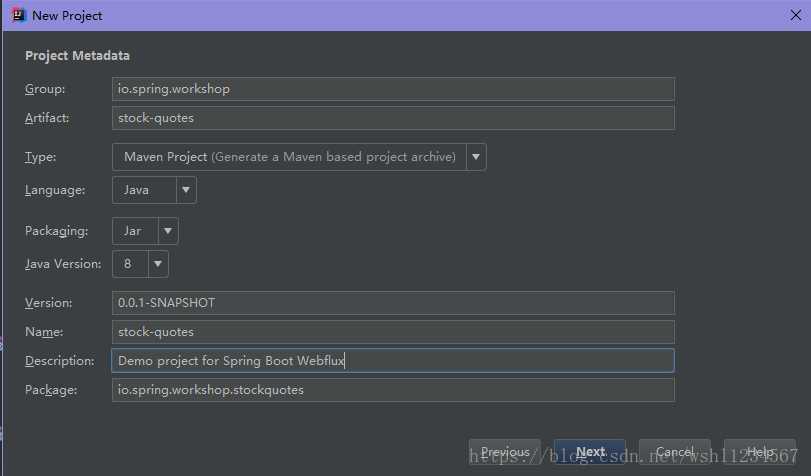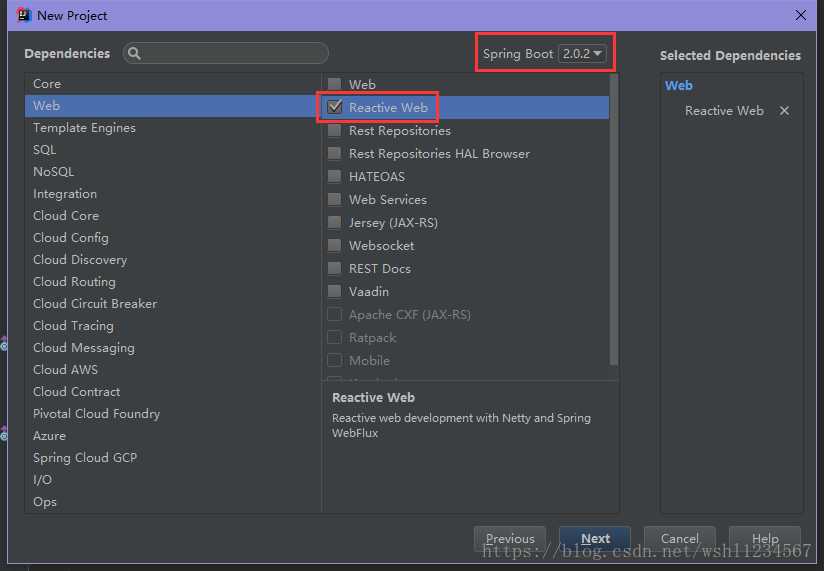标签:流处理 ams 编程 rate detail react instant turn ant
什么是webFlux
左侧是传统的基于Servlet的Spring Web MVC框架,右侧是5.0版本新引入的基于Reactive Streams的Spring WebFlux框架,从上到下依次是Router Functions,WebFlux,Reactive Streams三个新组件。
Router Functions: 对标@Controller,@RequestMapping等标准的Spring MVC注解,提供一套函数式风格的API,用于创建Router,Handler和Filter。
WebFlux: 核心组件,协调上下游各个组件提供响应式编程支持。
Reactive Streams: 一种支持背压(Backpressure)的异步数据流处理标准,主流实现有RxJava和Reactor,Spring WebFlux默认集成的是Reactor。
在Web容器的选择上,Spring WebFlux既支持像Tomcat,Jetty这样的的传统容器(前提是支持Servlet 3.1 Non-Blocking IO API),又支持像Netty,Undertow那样的异步容器。不管是何种容器,Spring WebFlux都会将其输入输出流适配成Flux<DataBuffer>格式,以便进行统一处理。
值得一提的是,除了新的Router Functions接口,Spring WebFlux同时支持使用老的Spring MVC注解声明Reactive Controller。和传统的MVC Controller不同,Reactive Controller操作的是非阻塞的ServerHttpRequest和ServerHttpResponse,而不再是Spring MVC里的HttpServletRequest和HttpServletResponse。
@GetMapping("/reactive/restaurants") public Flux<Restaurant> findAll() { return restaurantRepository.findAll(); }
可以看到主要变化就是在 返回的类型上Flux<Restaurant>
Flux和Mono 是 Reactor 中的流数据类型,其中Flux会发送多次,Mono会发送0次或一次
使用webflux需要具备的基础是Reactive programming 的理解。
Reactor 的基础 和 熟练的java8 lambda使用
创建springboot应用
下面通过创建股票报价的demo来演示。
通过 https://start.spring.io 或idea自带功能创建springboot项目,groupId为io.spring.workshop,artifactId为 stock-quotes。

勾选 ReactiveWeb

修改 application.properties 配置文件,指定接口 8081
server.port=8081
启动应用,成功后控制台输出日志

日志显示使用Netty而不是tomcat,后续会使用Tomcat
股票报价生成
定义实体
@Data public class Quote { private static final MathContext MATH_CONTEXT = new MathContext(2); private String ticker; private BigDecimal price; private Instant instant; public Quote() { } public Quote(String ticker, BigDecimal price) { this.ticker = ticker; this.price = price; } public Quote(String ticker, Double price) { this(ticker, new BigDecimal(price, MATH_CONTEXT)); } @Override public String toString() { return "Quote{" + "ticker=‘" + ticker + ‘\‘‘ + ", price=" + price + ", instant=" + instant + ‘}‘; } }
定义生成器
@Component public class QuoteGenerator { private final MathContext mathContext = new MathContext(2); private final Random random = new Random(); private final List<Quote> prices = new ArrayList<>(); /** * 生成行情数据 */ public QuoteGenerator() { this.prices.add(new Quote("CTXS", 82.26)); this.prices.add(new Quote("DELL", 63.74)); this.prices.add(new Quote("GOOG", 847.24)); this.prices.add(new Quote("MSFT", 65.11)); this.prices.add(new Quote("ORCL", 45.71)); this.prices.add(new Quote("RHT", 84.29)); this.prices.add(new Quote("VMW", 92.21)); } public Flux<Quote> fetchQuoteStream(Duration period) { // 需要周期生成值并返回,使用 Flux.interval return Flux.interval(period) // In case of back-pressure, drop events .onBackpressureDrop() // For each tick, generate a list of quotes .map(this::generateQuotes) // "flatten" that List<Quote> into a Flux<Quote> .flatMapIterable(quotes -> quotes) .log("io.spring.workshop.stockquotes"); } /** * Create quotes for all tickers at a single instant. */ private List<Quote> generateQuotes(long interval) { final Instant instant = Instant.now(); return prices.stream() .map(baseQuote -> { BigDecimal priceChange = baseQuote.getPrice() .multiply(new BigDecimal(0.05 * this.random.nextDouble()), this.mathContext); Quote result = new Quote(baseQuote.getTicker(), baseQuote.getPrice().add(priceChange)); result.setInstant(instant); return result; }) .collect(Collectors.toList()); } }
webflux的使用有两种方式,基于注解和函数式编程。这里使用函数式编程,先贴代码:
创建QuoteHandler
@Component public class QuoteHandler { private final Flux<Quote> quoteStream; public QuoteHandler(QuoteGenerator quoteGenerator) { this.quoteStream = quoteGenerator.fetchQuoteStream(ofMillis(1000)).share(); } public Mono<ServerResponse> hello(ServerRequest request) { return ok().contentType(TEXT_PLAIN) .body(BodyInserters.fromObject("Hello Spring!")); } public Mono<ServerResponse> echo(ServerRequest request) { return ok().contentType(TEXT_PLAIN) .body(request.bodyToMono(String.class), String.class); } public Mono<ServerResponse> streamQuotes(ServerRequest request) { return ok() .contentType(APPLICATION_STREAM_JSON) .body(this.quoteStream, Quote.class); } public Mono<ServerResponse> fetchQuotes(ServerRequest request) { int size = Integer.parseInt(request.queryParam("size").orElse("10")); return ok() .contentType(APPLICATION_JSON) .body(this.quoteStream.take(size), Quote.class); } }
创建Router
@Configuration public class QuoteRouter { @Bean public RouterFunction<ServerResponse> route(QuoteHandler quoteHandler) { return RouterFunctions .route(GET("/hello").and(accept(TEXT_PLAIN)), quoteHandler::hello) .andRoute(POST("/echo").and(accept(TEXT_PLAIN).and(contentType(TEXT_PLAIN))), quoteHandler::echo) .andRoute(GET("/quotes").and(accept(APPLICATION_JSON)), quoteHandler::fetchQuotes) .andRoute(GET("/quotes").and(accept(APPLICATION_STREAM_JSON)), quoteHandler::streamQuotes); } }
需要注意的是在springboot中Handler和Router都需要打上@Configuration。
HTTP请求交由Router转发给对应的Handler,Handler处理请求,并返回Mono<ServerResponse>,这里的Router类似@RequestMapping,Handler类似Controller。这么理解非常容易。
运行项目,浏览器输入 http://localhost:8081/hello 或者 使用curl,即可收到 "Hello Spring!"的文本信息。
到目前为止,一个简单的webflux示例已经完成,但是还没有体现出它与传统模式有何不同。
下面我们来做一下测试:
$ curl http://localhost:8081/echo -i -d "WebFlux workshop" -H "Content-Type: text/plain" HTTP/1.1 200 OK transfer-encoding: chunked Content-Type: text/plain WebFlux workshop
还是没有区别T.T,看下一步。
$ curl http://localhost:8081/quotes -i -H "Accept: application/stream+json" HTTP/1.1 200 OK transfer-encoding: chunked Content-Type: application/stream+json {"ticker":"CTXS","price":82.77,"instant":"2018-05-15T06:45:51.261Z"} {"ticker":"DELL","price":64.83,"instant":"2018-05-15T06:45:51.261Z"} {"ticker":"GOOG","price":881,"instant":"2018-05-15T06:45:51.261Z"} {"ticker":"MSFT","price":67.3,"instant":"2018-05-15T06:45:51.261Z"} {"ticker":"ORCL","price":48.1,"instant":"2018-05-15T06:45:51.261Z"} {"ticker":"RHT","price":85.1,"instant":"2018-05-15T06:45:51.261Z"} {"ticker":"VMW","price":92.24,"instant":"2018-05-15T06:45:51.261Z"} -------------------------------无敌分割线------------------------------------- {"ticker":"CTXS","price":85.7,"instant":"2018-05-15T06:45:52.260Z"} {"ticker":"DELL","price":64.12,"instant":"2018-05-15T06:45:52.260Z"} {"ticker":"GOOG","price":879,"instant":"2018-05-15T06:45:52.260Z"} {"ticker":"MSFT","price":67.9,"instant":"2018-05-15T06:45:52.260Z"} {"ticker":"ORCL","price":46.43,"instant":"2018-05-15T06:45:52.260Z"} {"ticker":"RHT","price":86.8,"instant":"2018-05-15T06:45:52.260Z"} ...
上面的分割线是为了易于分辨人为加上去的,我们看到返回结果每隔一秒刷新一次,不终止的话会一直返回数据,传统的Request/Response是一次请求,一次返回。
注意是设置了Header Accept: application/stream+json ,
如果将Header设置为 Accept: application/json ,只会得到一次Response。
写测试
springboot的test模块包含WebTestClient,可以用来对webflux服务端进行测试。
@RunWith(SpringRunner.class) // We create a `@SpringBootTest`, starting an actual server on a `RANDOM_PORT` @SpringBootTest(webEnvironment = SpringBootTest.WebEnvironment.RANDOM_PORT) public class StockQuotesApplicationTests { // Spring Boot will create a `WebTestClient` for you, // already configure and ready to issue requests against "localhost:RANDOM_PORT" @Autowired private WebTestClient webTestClient; @Test public void fetchQuotes() { webTestClient // We then create a GET request to test an endpoint .get().uri("/quotes?size=20") .accept(MediaType.APPLICATION_JSON) .exchange() // and use the dedicated DSL to test assertions against the response .expectStatus().isOk() .expectHeader().contentType(MediaType.APPLICATION_JSON) .expectBodyList(Quote.class) .hasSize(20) // Here we check that all Quotes have a positive price value .consumeWith(allQuotes -> assertThat(allQuotes.getResponseBody()) .allSatisfy(quote -> assertThat(quote.getPrice()).isPositive())); } @Test public void fetchQuotesAsStream() { List<Quote> result = webTestClient // We then create a GET request to test an endpoint .get().uri("/quotes") // this time, accepting "application/stream+json" .accept(MediaType.APPLICATION_STREAM_JSON) .exchange() // and use the dedicated DSL to test assertions against the response .expectStatus().isOk() .expectHeader().contentType(MediaType.APPLICATION_STREAM_JSON) .returnResult(Quote.class) .getResponseBody() .take(30) .collectList() .block(); assertThat(result).allSatisfy(quote -> assertThat(quote.getPrice()).isPositive()); } }
参考文章:
https://docs.spring.io/spring-framework/docs/5.0.3.RELEASE/spring-framework-reference/web.html#web-reactive-server-functional
http://projectreactor.io/docs
https://www.ibm.com/developerworks/cn/java/spring5-webflux-reactive/index.html
https://blog.csdn.net/qq_34438958/article/details/78539234
springboot 使用webflux响应式开发教程(一)
标签:流处理 ams 编程 rate detail react instant turn ant
原文地址:https://www.cnblogs.com/zhujiabin/p/9849669.html